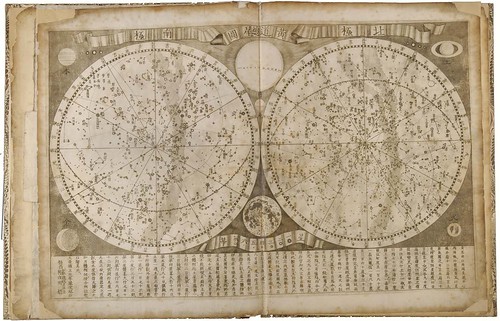Globus Coelestis Sinicus Explicatus
[China, Beijing and Russia, St Petersburg], 18th century
Sp Coll MS Hunter 10 (S.1.10)
This book contains a Chinese copper plate engraving of a star map, bound in with a manuscript in Latin and Chinese. The manuscript’s author, Theophilus (Gottlieb) Siegfried Bayer (1726-1738), was a sinologist and Professor of Greek and Roman Antiquities at St Petersburg Academy of Sciences in the early 18th Century.
The engraved map is by Ignatius Kögler, a member of the Portuguese Jesuit house at Beijing. He was appointed President of the Bureau of Astronomy and Mathematics at the Ch’ing court under the emperor K’ang-hsi. The map represents the northern (right) and southern (left) stellar hemispheres. The title, in Chinese characters, is translated as “Table of the Ecliptic and of all the Stars”.
The ecliptic (the apparent path of the sun across the sky) and stars are marked on the map. Jupiter, the sun, Mars, Mercury the moon and Venus are represented in the cross-hatched border. In the lower margin, the names of the stars represented on the map are listed in columns. Bayer’s manuscript transliterates and translates into Latin the Chinese names for the hemispheres, the planets and the signs of the zodiac. It also explains the star map’s ranking according to seven orders of stars, including nebulae. It transliterates and gives Latin equivalents for the stars listed on the map, assigning them to constellations.

Image: engraved star map, representing the northern (right) and southern (left) stellar hemispheres.
Go to the next book in the exhibition: Lecture Notes Given by John Tran (1687-88)



